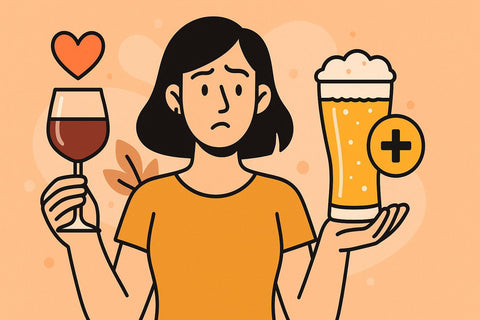Wine glasses clink at weddings, beer bottles crack open at backyard barbecues. These two drinks have long been the social glue of gatherings, the punctuation marks of celebration, and, for some, a nightly ritual. But beyond the clinking and sipping, there’s a quieter conversation that’s been brewing (or fermenting, depending on your preference): which one is actually better for your health?
It’s a question that’s sparked debates at dinner tables and headlines in health magazines. Wine, especially red, has been hailed as heart-healthy. Beer, on the other hand, often gets lumped in with pizza and football — not exactly the poster child for wellness. But the truth is more nuanced. Both beverages come with their own set of nutritional perks and potential pitfalls.
This article takes a detailed look at the nutritional content, health benefits, and risks associated with wine and beer. Whether you're a casual drinker, a health-conscious consumer, or just curious where your favorite drink stands, here's what you need to know.
Nutritional Breakdown: Wine vs. Beer
Caloric Content
Calories are often the first concern when comparing alcoholic beverages. A standard 5-ounce glass of wine contains around 120–130 calories, depending on the type. Red wines tend to be slightly higher in calories than whites due to their higher alcohol and sugar content. Beer, on the other hand, varies more widely. A 12-ounce serving of regular beer averages 150–200 calories, while light beers can dip as low as 90–100.
Alcohol content plays a big role here. Since alcohol itself contains 7 calories per gram, drinks with higher alcohol by volume (ABV) naturally pack more calories. This is why a high-ABV craft beer can rival a dessert in calorie count.
Carbohydrates and Sugar
Beer is typically higher in carbohydrates, thanks to the grains used in brewing. A regular beer can contain 10–15 grams of carbs per serving, while light beers hover around 3–6 grams. Wine, particularly dry varieties, contains fewer carbs — often under 4 grams per glass.
Sugar content is another differentiator. Dry red and white wines contain minimal residual sugar, usually under 1 gram per glass. Sweet wines and sparkling varieties, however, can contain 5 grams or more. Beer generally contains less sugar but more complex carbs, which can still impact blood sugar levels.
Vitamins and Minerals
Beer has a surprisingly robust nutrient profile. It contains B vitamins like niacin, riboflavin, and folate, as well as minerals such as magnesium, phosphorus, and silicon — the latter of which is linked to bone health. Unfiltered or craft beers tend to retain more of these nutrients.
Wine, particularly red wine, is rich in antioxidants like resveratrol and flavonoids. These compounds are thought to support heart health and reduce inflammation. Wine also contains small amounts of potassium, iron, and manganese, though not in significant quantities.
Alcohol by Volume (ABV)
Wine usually has a higher ABV than beer. Most wines fall between 12–15% ABV, while beers range from 4–7%, with some craft varieties exceeding 10%. Higher ABV means more alcohol per serving, which can amplify both the benefits and risks associated with consumption.
The body processes alcohol the same way regardless of the source, but the concentration affects how quickly it enters the bloodstream. This can influence everything from intoxication levels to long-term health outcomes.
Health Benefits of Wine
Cardiovascular Health
Red wine has long been associated with heart health, largely due to the “French Paradox” — the observation that French populations have low rates of heart disease despite diets high in saturated fats. Moderate red wine consumption is thought to play a role.
Studies suggest that compounds like resveratrol and flavonoids in red wine may help reduce LDL (bad) cholesterol, increase HDL (good) cholesterol, and improve blood vessel function. A 2018 review published in the journal Molecules supports these findings, though it also notes that more research is needed to establish causality.
Antioxidant Properties
Red wine is rich in polyphenols — plant-based compounds that act as antioxidants. These help neutralize free radicals, which can damage cells and contribute to aging and disease. White wine contains fewer polyphenols due to differences in production, but still offers some antioxidant benefits.
The skin of red grapes, used in red wine production, is where most of these antioxidants are found. That’s why red wine typically outshines white in this department.
Potential Longevity Benefits
The Mediterranean diet, which includes moderate wine consumption, has been linked to increased lifespan and reduced risk of chronic diseases. A study published in The BMJ found that adherence to this diet correlated with lower mortality rates, especially from cardiovascular causes.
While wine isn’t the sole contributor, its inclusion in a balanced, plant-rich diet may offer synergistic benefits.
Mental Health and Cognitive Function
Some observational studies have linked moderate wine consumption to a reduced risk of dementia and Alzheimer’s disease. The antioxidants in wine may help protect brain cells from oxidative stress and inflammation.
However, this is a delicate balance. Excessive alcohol consumption is a known risk factor for cognitive decline, so moderation is key.
Health Benefits of Beer
Heart Health
Beer doesn’t often get the same heart-healthy spotlight as wine, but it’s not without merit. Moderate beer consumption has been associated with reduced risk of heart disease in several studies. A 2013 meta-analysis in Nutrition, Metabolism & Cardiovascular Diseases found that moderate beer intake was linked to a 25% lower risk of heart disease.
The mechanisms may involve increased HDL cholesterol and anti-inflammatory effects, similar to wine.
Bone Health
Beer is a notable source of dietary silicon, which plays a role in bone formation and maintenance. Pale ales and other malt-forward beers tend to have higher silicon content.
A study published in the American Journal of Clinical Nutrition found that higher silicon intake was associated with greater bone mineral density in men and premenopausal women.
Nutrient Profile
Beer contains several B vitamins, including B6 and folate, which support energy metabolism and red blood cell production. It also provides small amounts of magnesium, potassium, and fiber — especially in unfiltered or whole-grain beers.
While you wouldn’t rely on beer for your daily nutrients, its composition is more complex than many assume.
Gut Health and Fermentation
Some craft and unfiltered beers may contain live yeast and beneficial bacteria, offering mild probiotic effects. These can support gut health by promoting a balanced microbiome.
However, this benefit is limited to specific types of beer and is not a substitute for fermented foods like yogurt or kimchi.
Health Risks of Wine and Beer
Alcohol Dependency and Abuse
Regardless of the drink, alcohol carries the risk of dependency. The line between moderate and excessive consumption can blur quickly, especially in cultures where drinking is normalized.
Serving sizes also matter. A “glass” of wine at home might be closer to 8 ounces than the standard 5, and a pint of beer often exceeds the 12-ounce baseline. These discrepancies can lead to unintentional overconsumption.
Liver Health
Chronic alcohol use is a leading cause of liver disease, including fatty liver, hepatitis, and cirrhosis. While moderate drinking is generally considered safe for most people, individual tolerance varies.
There’s no clear evidence that wine is less harmful to the liver than beer. The key factor is total alcohol intake over time.
Weight Gain and Metabolic Effects
The term “beer belly” exists for a reason, but wine isn’t off the hook either. Excess calories from alcohol can contribute to weight gain, especially when combined with poor dietary habits.
Beer’s higher carb content may lead to more noticeable bloating, while wine’s sugar content can spike insulin levels. Both can impact metabolism if consumed in excess.
Cancer Risk
Alcohol is classified as a Group 1 carcinogen by the World Health Organization. It’s linked to increased risk of several cancers, including breast, liver, colorectal, and esophageal.
The risk increases with the amount consumed, regardless of whether the source is wine, beer, or spirits. Some studies suggest that red wine’s antioxidants may offer slight protective effects, but they don’t negate the risks of alcohol itself.
Moderation and Drinking Guidelines
The Centers for Disease Control and Prevention (CDC) defines moderate drinking as up to one drink per day for women and up to two for men. The World Health Organization offers similar guidance.
Gender differences in alcohol metabolism mean that women generally process alcohol more slowly, leading to higher blood alcohol levels from the same amount.
To drink mindfully:
- Stick to standard serving sizes (5 oz wine, 12 oz beer)
- Alternate with water to stay hydrated
- Don’t drink on an empty stomach
- Take alcohol-free days each week
Incorporating wine or beer into a healthy lifestyle means being intentional — not just about how much you drink, but why.
Cultural and Lifestyle Considerations
Drinking habits are shaped by more than personal preference. In some cultures, wine is a staple of daily meals, while in others, beer is the go-to for socializing. These norms influence not just consumption patterns but also health outcomes.
Accessibility and affordability also play a role. Beer tends to be cheaper and more widely available, which can lead to higher consumption in certain populations. Wine, often seen as more refined, may be consumed more slowly and in smaller quantities.
Social context matters. A glass of wine with dinner is different from binge-drinking beer at a party. The setting, frequency, and intent all shape the health impact.
Choosing What Works for You
So, is wine better for you than beer? The answer depends on what you’re looking for — and how you drink it. Wine may edge out beer in terms of antioxidant content and heart health, especially red wine. Beer, however, offers its own nutritional perks, including B vitamins and silicon for bone health.
But these benefits only apply within the boundaries of moderation. Once you cross that line, the risks — from liver damage to cancer — start to outweigh the perks.
Ultimately, the healthiest choice is the one that fits your lifestyle, your body, and your goals. And if you’re unsure, it’s always worth checking in with a healthcare provider who can help you make a decision grounded in your personal health profile.
FAQs
Is red wine better than white wine for health?
Generally, yes. Red wine contains more antioxidants like resveratrol due to fermentation with grape skins. However, both red and white wines can be part of a healthy diet when consumed in moderation.
Can beer be part of a healthy diet?
Absolutely — in moderation. Beer offers nutrients like B vitamins and silicon, and some studies support its role in heart and bone health. Just be mindful of portion sizes and frequency.
What is the healthiest type of alcohol?
There’s no definitive “healthiest” alcohol, but red wine is often cited for its antioxidant content. That said, the healthiest option is the one you consume responsibly and enjoy occasionally.
How much wine or beer is safe to drink per week?
According to most guidelines, up to 7 drinks per week for women and 14 for men is considered moderate. But individual tolerance, medical conditions, and lifestyle factors can shift what’s safe for you.







